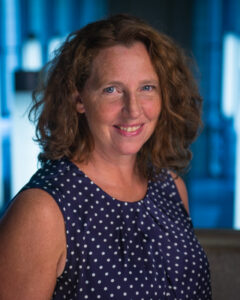
Using Your Certification in ACUE’s Framework to Build Learning Communities
Congratulations! You’ve successfully earned your certification in the ACUE Framework, a significant achievement that recognizes your dedication to your students and your craft as an educator. Obtaining a certification in the ACUE Framework is just the start of a never-ending commitment to teaching excellence and student success. Now that you’ve mastered the basics, you can set out to make every semester better than before, sharing your learnings and expertise with fellow faculty to create a more engaging, inclusive, and effective learning environment for the university as a whole. Follow these steps to help you expand your learnings beyond certification, and spark intrigue for fellow faculty who will leave inspired to follow your example and dedication toward student success.
Reference Your ACUE Curriculum
Like a favorite book you keep coming back to, you’ll gain deeper insights every time you reference back to the ACUE curriculum. Delving back into the course content will allow you to pick up on concepts that you may have overlooked on the first go or may trigger an idea on how to adjust your lesson plan to meet the needs of a new student. ACUE’s comprehensive courses for certification, thoughtfully designed modules, and practical insights will serve as your invaluable compass, guiding you toward new heights of excellence in the classroom.

One exceptional tool at your disposal is the “What’s Next Report” within the ACUE course. This insightful report, created from the “Notes to Future Self” you diligently compose as you implement new teaching practices and reflect on them, will act as a road map. Embrace the opportunity to leverage this guidance and return to your reflections and thought processes from your time in the course as you continue to refine your teaching practices and cultivate an environment that fosters student engagement and success.
Become a Leader
Earning your certification in the ACUE Framework not only signifies a momentous achievement but also exemplifies your unwavering dedication to continually enriching your teaching tool kit. It showcases your profound commitment to staying at the forefront of educational best practices, ensuring that you remain a dynamic and effective educator for the benefit of your students. By undertaking this journey, you have equipped yourself with an array of evidence-based teaching practices and innovative approaches that are tailored to meet the diverse learning needs of your students.

In your quest for leadership and continued growth as an instructor, the possibilities are boundless. You might consider taking the initiative to organize workshops or training sessions, providing a platform for educators to delve deeper into the effective teaching methodologies you’ve discovered through ACUE.
As you embrace your role as a leader, mentor, and lifelong learner, your certification in the ACUE Framework becomes a springboard for professional excellence and an emblem of your commitment to student success. Embrace the opportunity to inspire and be inspired, to empower and be empowered, as you continue your growth as an instructor and shape the future of education, one collaborative step at a time.
Share Best Practices
As mentioned in the previous step, take the opportunity to amplify the impact of your ACUE experience and elevate your leadership role within your institution by actively sharing your newfound knowledge and insights with your colleagues. Embrace the role of a mentor and advocate for effective teaching practices as you impart the wisdom gained from your journey. By generously sharing your favorite and most impactful ACUE practices with your fellow educators, you create a ripple effect of positive change that reverberates throughout your campus.

Engaging in this knowledge-sharing endeavor not only fosters a supportive and collaborative teaching community but also catalyzes a transformative educational environment. As you candidly discuss your experiences, challenges, and triumphs, you inspire your colleagues to explore innovative teaching methods and embrace evidence-based teaching practices. Your willingness to open up about the strategies that have truly resonated with you empowers your peers to reflect on their own pedagogical practices and discover novel ways to enhance student engagement and success.
In the spirit of collaboration, collective growth, and the pursuit of academic excellence, your proactive efforts to share ACUE’s effective practices will lead to a more robust and dynamic educational ecosystem. The collaborative synergy created among educators through this knowledge-sharing process fosters a sense of camaraderie, where collective wisdom becomes a powerful force for positive change.
Organize Learning Moments

Some ACUE faculty have been sharing teaching practices with their department colleagues, encouraging them to take small risks in their teaching approaches. Others engage in informal conversations to discuss what works (and what doesn’t) in their classes. We’ve received feedback that keeping these presentations to one or two tips is ideal. We strongly encourage you to consider taking on these types of leadership moments to share, showcase, and expand your learning with colleagues, playing an integral role in building stronger teaching communities.
For instance, in 2021, the University of Toronto introduced a monthly Faculty ACUE Lunch and Learn Series. During this series, our faculty certified in the ACUE Framework stepped up to lead one-hour webinars, focusing on one core ACUE module implementation that had personally resonated with their own learning. This series invited participants to hear from certified instructors to explore and practice with real-life examples and tips that were informed by evidence-based strategies.
During these webinars, faculty extended their ACUE course learning and focused on innovative topics such as: “Adventures in (UN)Grading: How to Stop Counting and Engage More Deeply With Students and Their Work,” presented by Deborah Tihanyi, Associate Professor, Teaching Stream, Engineering Communication Program (ECP), Institute for Studies in Transdisciplinary Engineering Education and Practice (ISTEP), University of Toronto. Another topic explored was “My Journey to Incorporating Equity, Diversity, Inclusion and Accessibility (EDIA) Meaningfully into My Teaching,” presented by Toula Kourgiantakis, Associate Professor, Teaching Stream, Factor-Inwentash Faculty of Social Work, University of Toronto.
The webinars garnered great interest, with an average of 40–50 instructors participating in each session. These events served as valuable spaces for hearing from faculty certified in the ACUE Framework who had taken “risks” in their teaching and were open to discussions about expanding one’s learning. The goal was to foster a supportive environment for instructors to stretch their teaching methods and embrace new approaches to enrich their educational practices.
So remember, obtaining a certification in the ACUE Framework is not the end of the journey but rather the beginning of an ongoing commitment to professional growth and excellence in teaching. As a passionate educator, you hold the key to unlocking endless opportunities for refining your instructional craft. Beyond the certification, the quest for continuous improvement requires an unyielding dedication to lifelong learning and a willingness to embrace new challenges. Stay connected with the ACUE community and draw inspiration from your fellow educators, sharing your experiences and insights to foster a collaborative and supportive environment.
About the Authors

Dr. Cindy Blackwell
Dr. Blackwell is an Academic Director at ACUE. Cindy was a tenured associate professor at Oklahoma State University before moving to The University of Southern Mississippi (USM), where she earned ACUE’s certification in the Effective Teaching Practice Framework in 2017. She also served as a facilitator for USM ACUE cohorts and as the associate director for the Center for Faculty Development at USM. Blackwell’s solid focus on students and student learning led her to be honored with USM’s University Excellence in Teaching Award in 2019.

Cora McCloy, PhD
Cora is a Faculty Liaison Coordinator at the Centre for Teaching Support & Innovation (CTSI), University of Toronto. Cora coordinates Scholarship of Teaching and Learning (SoTL) programming at the CTSI alongside supporting instructors across the university in a wide range of teaching topics: teaching dossiers, SoTL, course design, observations of teaching, and teaching award files. She also co-facilitates more intensive cohort programming, including with ACUE.




